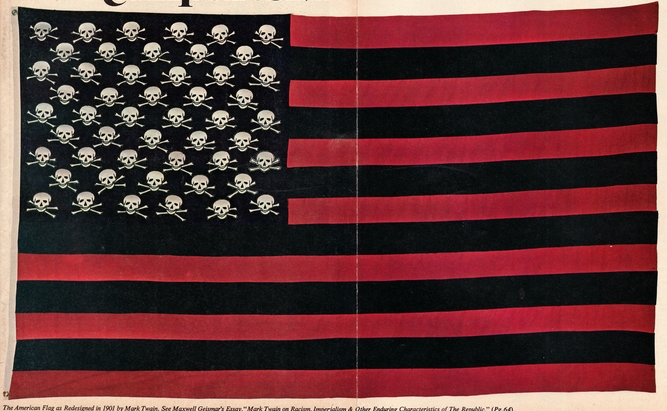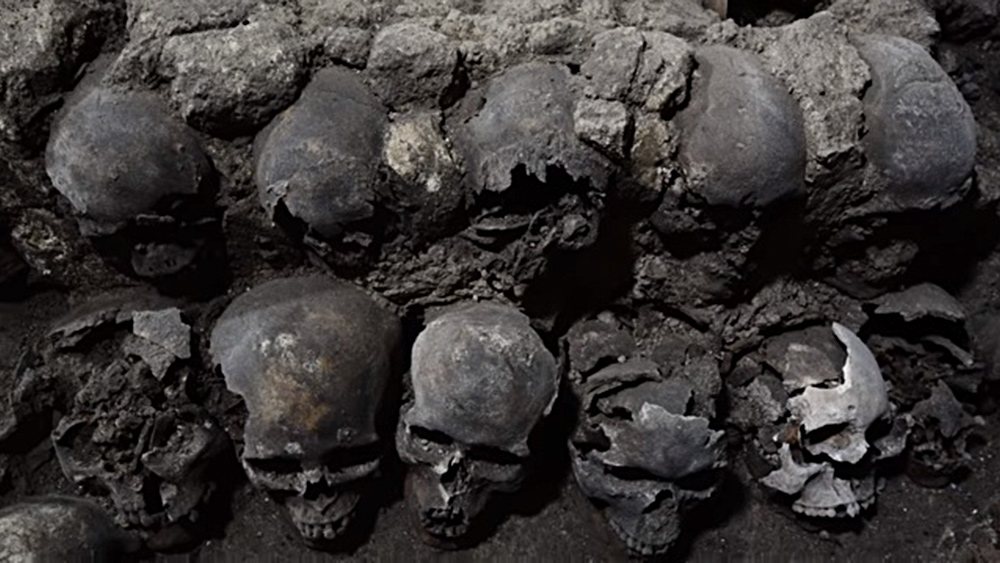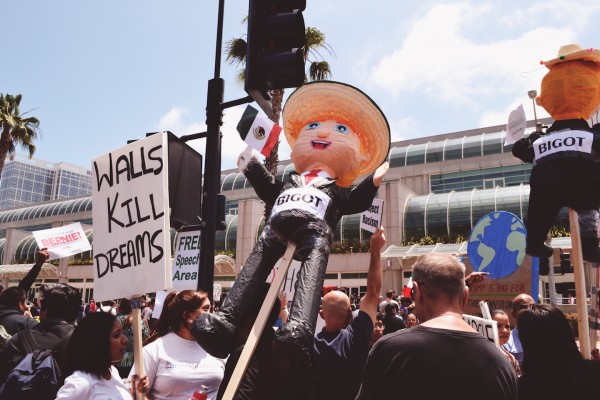“[America] goes not abroad in search of monsters to destroy…. She well knows that by once enlisting under other banners than her own, were they even the banners of foreign independence, she would involve herself, beyond the power of extrication, in all the wars of interest and intrigue, of individual avarice, envy, and ambition, which assume the colors and usurp the standard of freedom. The fundamental maxims of her policy would insensibly change from liberty to force. The frontlet upon her brows would no longer beam with the ineffable splendor of freedom and independence; but in its stead would soon be substituted an imperial diadem, flashing in false and tarnished lustre the murky radiance of dominion and power. She might become the dictatress of the world: she would be no longer the ruler of her own spirit.“[1]
– John Quincy Adams, July 4, 1821
“…we can have just our usual flag, with the white stripes painted black and the stars replaced with the skull and cross-bones.”[2]
– Mark Twain, regarding the U.S. conquest of the Philippines in 1899
The following list was compiled by the Congressional Research Service, and published under the title Instances of Use of United States Forces Abroad, 1798-2015.[3] (It’s updated every few years.) Richard F. Grimmett, retired CRS specialist in International Security, was the original author of this report. The report has since been updated by the current author, Barbara Salazar Torreon, Analyst in Defense Budget and Military Manpower.
As this list shows, the United States has invaded other countries hundreds of times. It’s interesting to note, however, that it has formally declared war only 11 times.
From the Summary:
“Eleven times in its history, the United States has formally declared war against foreign nations. These 11 U.S. war declarations encompassed five separate wars: the war with Great Britain declared in 1812; the war with Mexico declared in 1846; the war with Spain declared in 1898; the First World War, during which the United States declared war with Germany and with Austria-Hungary during 1917; and World War II, during which the United States declared war against Japan, Germany, and Italy in 1941, and against Bulgaria, Hungary, and Rumania in 1942.”
Here’s a list of the invasions from 1900-1949, copied verbatim from the Congressional Research Service report, which is in the public domain. Remember, this is an official U.S. government history, so naturally, every invasion is described as a benevolent venture to “protect American interests,” etc.
(Click here to read Part 1: The 1800s.)
1900
China. May 24 to September 28. American troops participated in operations to protect foreign lives during the Boxer rising,
particularly at Peking. For many years after this experience a permanent legation guard was maintained in Peking, and was
strengthened at times as trouble threatened.
1901
Colombia (State of Panama). November 20 to December 4. U.S. forces protected American property on the Isthmus and kept transit lines open during serious revolutionary disturbances.
1902
Colombia – April 16 to 23. U.S. forces protected American lives and property at Bocas del Toro during a civil war.
1902
Colombia (State of Panama). September 17 to November 18. The United States placed armed guards on all trains crossing the Isthmus to keep the railroad line open, and stationed ships on both sides of Panama to prevent the landing of Colombian troops.
1903
Honduras. March 23 to 30 or 31. U.S. forces protected the American consulate and the steamship wharf at Puerto Cortez during a period of revolutionary activity.
1903
Dominican Republic. March 30 to April 21. A detachment of marines was landed to protect American interests in the city of Santo Domingo during a revolutionary outbreak.
1903
Syria. September 7 to 12. U.S. forces protected the American consulate in Beirut when a local Moslem uprising was feared.
1903-04
Abyssinia. Twenty-five marines were sent to Abyssinia to protect the U.S. Consul General while he negotiated a treaty.
1903-14
Panama. U.S. forces sought to protect American interests and lives during and following the revolution for independence from Colombia over construction of the Isthmian Canal. With brief intermissions, United States Marines were stationed on the Isthmus from November 4, 1903, to January 21, 1914, to guard American interests.
1904
Dominican Republic. January 2 to February 11. American and British naval forces established an area in which no fighting would be allowed and protected American interests in Puerto Plata and Sosua and Santo Domingo City during revolutionary fighting.
1904
Tangier, Morocco. “We want either Perdicaris alive or Raisula dead.” A squadron demonstrated to force release of a kidnapped American. Marines were landed to protect the consul general.
1904
Panama. November 17 to 24. U.S. forces protected American lives and property at Ancon at the time of a threatened insurrection.
1904-05
Korea. January 5, 1904, to November 11, 1905. A guard of Marines was sent to protect the American legation in Seoul during the
Russo-Japanese War.
1906-09
Cuba. September 1906 to January 23, 1909. U.S. forces sought to restore order, protect foreigners, and establish a stable government after serious revolutionary activity.
1907
Honduras. March 18 to June 8. To protect American interests during a war between Honduras and Nicaragua, troops were stationed in Trujillo, Ceiba, Puerto Cortez, San Pedro, Laguna and Choloma.
1910
Nicaragua. May19 to September 4. U.S. forces protected American interests at Bluefields.
1911
Honduras. January 26. American naval detachments were landed to protect American lives and interests during a civil war in Honduras.
1911
China. As the nationalist revolution approached, in October an ensign and 10 men tried to enter Wuchang to rescue missionaries but retired on being warned away, and a small landing force guarded American private property and consulate at Hankow. Marines were deployed in November to guard the cable stations at Shanghai; landing forces were sent for protection in Nanking, Chinkiang, Taku and elsewhere.
1912
Honduras. A small force landed to prevent seizure by the government of an American-owned railroad at Puerto Cortez. The
forces were withdrawn after the United States disapproved the action.
1912
Panama. Troops, on request of both political parties, supervised elections outside the Canal Zone.
1912
Cuba. June 5 to August 5. U.S. forces protected American interests on the Province of Oriente, and in Havana.
1912
China. August 24 to 26, on Kentucky Island, and August 26 to 30 at Camp Nicholson. U.S. forces protected Americans and American interests during revolutionary activity.
1912
Turkey. November 18 to December 3. U.S. forces guarded the American legation at Constantinople during a Balkan War.
1912-25
Nicaragua. August to November 1912. U.S. forces protected American interests during an attempted revolution. A small force,
serving as a legation guard and seeking to promote peace and stability, remained until August 5, 1925.
1912-41
China. The disorders which began with the overthrow of the dynasty during Kuomintang rebellion in 1912, which were redirected by the invasion of China by Japan, led to demonstrations and landing parties for the protection of U.S. interests in China continuously and at many points from 1912 on to 1941. The guard at Peking and along the route to the sea was maintained until 1941. In1927, the United States had 5,670 troops ashore in China and 44 naval vessels in its waters. In 1933 the United States had 3,027 armed men ashore. The protective action was generally based on treaties with China
concluded from 1858 to 1901.
1913
Mexico. September 5 to 7. A few marines landed at Ciaris Estero to aid in evacuating American citizens and others from the Yaqui Valley, made dangerous for foreigners by civil strife.
1914
Haiti. January 29 to February 9, February 20 to 21, October 19. Intermittently U.S. naval forces protected American nationals in a time of rioting and revolution.
1914
Dominican Republic. June and July. During a revolutionary movement, United States naval forces by gunfire stopped the
bombardment of Puerto Plata, and by threat of force maintained Santo Domingo City as a neutral zone.
1914-17
Mexico. Undeclared Mexican-American hostilities followed the Dolphin affair and Villa’s raids and included capture of Vera Cruz and later Pershing’s expedition into northern Mexico.
1915-34
Haiti. July 28, 1915, to August 15, 1934. U.S. forces maintained order during a period of chronic political instability.
1916
China. American forces landed to quell a riot taking place on American property in Nanking.
1916-24
Dominican Republic. May1916 to September 1924. American naval forces maintained order during a period of chronic and threatened insurrection.
1917
China. American troops were landed at Chungking to protect American lives during a political crisis.
1917-18
World War I. On April 6, 1917, the United States declared war with Germany and on December 7, 1917, with Austria-Hungary. Entrance of the United States into the war was precipitated by Germany’s submarine warfare against neutral shipping.
1917-22
Cuba. U.S. forces protected American interests during an insurrection and subsequent unsettled conditions. Most of the United States armed forces left Cuba by August 1919, but two companies remained at Camaguey until February 1922.
1918-19
Mexico. After withdrawal of the Pershing expedition, U.S. troops entered Mexico in pursuit of bandits at least three times in 1918 and six times in 1919. In August 1918 American and Mexican troops fought at Nogales.
1918-20
Panama. U.S. forces were used for police duty according to treaty stipulations, at Chiriqui, during election disturbances and subsequent unrest.
1918-20
Soviet Russia. Marines were landed at and near Vladivostok in June and July to protect the American consulate and other points in the fighting between the Bolshevik troops and the Czech Army which had traversed Siberia from the western front. A joint proclamation of emergency government and neutrality was issued by the American, Japanese, British, French, and Czech commanders in July. In August 7,000 men were landed in Vladivostok and remained until January 1920, as part of an allied occupation force. In September 1918, 5,000 American troops joined the allied intervention force at Archangel and remained until June 1919. These operations were in response to the Bolshevik revolution in Russia and were partly supported by Czarist or Kerensky elements.
1919
Dalmatia. U.S. forces were landed at Trau at the request of Italian authorities to police order between the Italians and Serbs.
1919
Turkey. Marines from the U.S.S. Arizona were landed to guard the U.S. Consulate during the Greek occupation of Constantinople.
1919
Honduras. September 8 to 12. A landing force was sent ashore to maintain order in a neutral zone during an attempted revolution.
1920
China. March 14. A landing force was sent ashore for a few hours to protect lives during a disturbance at Kiukiang.
1920
Guatemala. April 9 to 27. U.S. forces protected the American Legation and other American interests, such as the cable station, during a period of fighting between Unionists and the Government of Guatemala.
1920-22
Russia (Siberia). February 16, 1920, to November 19, 1922. A Marine guard was sent to protect the United States radio station and property on Russian Island, Bay of Vladivostok.
1921
Panama – Costa Rica. American naval squadrons demonstrated in April on both sides of the Isthmus to prevent war between the two countries over a boundary dispute.
1922
Turkey. September and October. A landing force was sent ashore with consent of both Greek and Turkish authorities, to protect American lives and property when the Turkish Nationalists entered Smyrna.
1922-23
China. Between April 1922 and November 1923 marines were landed five times to protect Americans during periods of unrest.
1924
Honduras. February 28 to March 31, September 10 to 15. U.S. forces protected American lives and interests during election hostilities.
1924
China. September. Marines were landed to protect Americans and other foreigners in Shanghai during Chinese factional hostilities.
1925
China. January 15 to August 29. Fighting of Chinese factions accompanied by riots and demonstrations in Shanghai brought the landing of American forces to protect lives and property in the International Settlement.
1925
Honduras. April 19 to 21. U.S. forces protected foreigners at La Ceiba during a political upheaval.
1925
Panama. October 12 to 23. Strikes and rent riots led to the landing of about 600 American troops to keep order and protect American interests.
1926-33
Nicaragua. May 7 to June 5, 1926; August 27, 1926 to January 3, 1933. The coup d’etat of General Chamorro aroused revolutionary activities leading to the landing of American marines to protect the interests of the United States. United States forces came and went intermittently until January 3, 1933.
1926
China. August and September. The Nationalist attack on Hankow brought the landing of American naval forces to protect American citizens. A small guard was maintained at the consulate general even after September 16, when the rest of the forces were withdrawn. Likewise, when Nationalist forces captured Kiukiang, naval forces were landed for the protection of foreigners November 4 to 6.
1927
China. February. Fighting at Shanghai caused American naval forces and marines to be increased. In March a naval guard was stationed at the American consulate at Nanking after Nationalist forces captured the city. American and British destroyers later used shell fire to protect Americans and other foreigners. Subsequently additional forces of marines and naval vessels were stationed in the vicinity of Shanghai and Tientsin.
1932
China. American forces were landed to protect American interests during the Japanese occupation of Shanghai.
1933
Cuba. During a revolution against President Gerardo Machado naval forces demonstrated but no landing was made.
1934
China. Marines landed at Foochow to protect the American Consulate.
1940
Newfoundland, Bermuda, St. Lucia, Bahamas, Jamaica, Antigua, Trinidad, and British Guiana. Troops were sent to guard air and naval bases obtained by negotiation with Great Britain. These were sometimes called lend-lease bases.
1941
Greenland. Greenland was taken under protection of the United States in April.
1941
Netherlands (Dutch Guiana). In November the President ordered American troops to occupy Dutch Guiana, but by agreement with the Netherlands government in exile, Brazil cooperated to protect aluminum ore supply from the bauxite mines in Surinam.
1941
Iceland. Iceland was taken under the protection of the United States, with consent of its government, for strategic reasons.
1941
Germany. Sometime in the spring the President ordered the Navy to patrol ship lanes to Europe. By July U.S. warships were convoying and by September were attacking German submarines. In November, the Neutrality Act was partly repealed to protect U.S. military aid to Britain.
1941-45
World War II. On December 8, 1941, the United States declared war with Japan, on December 11 with Germany and Italy, and on June 5, 1942, with Bulgaria, Hungary and Rumania. The United States declared war against Japan after the surprise bombing of Pearl Harbor, and against Germany and Italy after those nations, under the dictators Hitler and Mussolini, declared war against the United States. The U.S. declared war against Bulgaria, Hungary and Rumania in response to the declarations of war by those nations against the United States.
1945
China. In October 50,000 U.S. Marines were sent to North China to assist Chinese Nationalist authorities in disarming and repatriating the Japanese in China and in controlling ports, railroads, and airfields. This was in addition to approximately 60,000 U.S. forces remaining in China at the end of World War II.
1946
Trieste. President Truman ordered the augmentation of U.S. troops along the zonal occupation line and the reinforcement of air forces in northern Italy after Yugoslav forces shot down an unarmed U.S. Army transport plane flying over Venezia Giulia. Earlier U.S. naval units had been dispatched to the scene.
1948
Palestine. A marine consular guard was sent to Jerusalem to protect the U.S. Consul General.
1948
Berlin. After the Soviet Union established a land blockade of the U.S., British, and French sectors of Berlin on June 24, 1948, the United States and its allies airlifted supplies to Berlin until after the blockade was lifted in May 1949.
1948-49
China. Marines were dispatched to Nanking to protect the American Embassy when the city fell to Communist troops, and to Shanghai to aid in the protection and evacuation of Americans.
To be continued…
Click here to read Part 1: The 1800s
Sources:
[1] TheAmericanConservative.com
[2] Loc.gov
[3] FAS.org



















